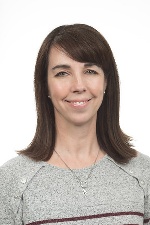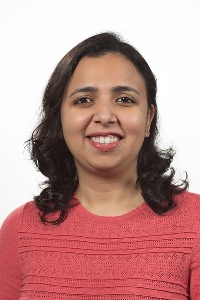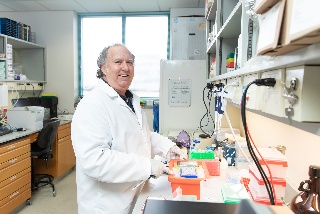The GSAF is a full service sequencing core that provides both Sanger and Next Generation Sequencing services, in addition to a library prep and quality check services, open access to equipment and training. The GSAF works directly with the bioinformatics core who can provide assist in any of your analysis needs to data storage solutions.
We are housed in
...
Our Resources
The Genomic Sequencing and Analysis Facility at the University of Texas at Austin is located in room 4.102 of the MBB building, which houses the ICMB. We perform next-gen sequencing and microarray studies for UT researchers from any department and from external research entities, both public and private. We are supported by UT's Texas Institute for Drug & Diagnostic Development and the Center for Systems and Synthetic Biology.
In approximately 2,000 square feet of controlled-access laboratory space and are an experienced NGS facility. Launched in 2008, the GSAF currently processes over 10, our facility currently includes:
- One Illumina HiSeq 2000 next-generation DNA sequencer and associated peripherals. The HiSeq can generate over 600 gigabases of sequence in an 11-day run. The GSAF has experience generating small RNA, mRNA, genomic DNA fragment, and genomic DNA large-insert mate-pair libraries for the Illumina platform.
- One Life Technologies SOLiD V4 next-generation DNA sequencer and associated peripherals. The 5500XL can generate over 200 gigabases of sequence using the unique 2-base encoding scheme for higher accuracy. As with the HiSeq, the GSAF has experience generating small RNA, mRNA, genomic DNA fragment, and genomic DNA large-insert mate-pair libraries for the SOLiD V4. (The GSAF also owns a Life Technologies 5500 XL but does not operate it routinely).
- One Roche 454 next-generation DNA sequencer (FLX with Titanium chemistry) and associated peripherals. The 454 FLX can generate over one million DNA sequences per day, with an average read length of over 400 base-pairs. As with the SOLiD, we can analyze one sample to great depth, or many samples in parallel to a lower depth.
- Informatic tools and hardware sufficient for analysis of next-generation DNA sequencing data, including:
- A Dell PowerEdge R900 server with four, quad-core E7340 Xeon, 2.4GHz processors (16 cores total), 1066Mhz FSB, 64 GB memory, and 5.6 TB RAID-6 disk space, with BWA, Bowtie, Shrimp, SOAP, and mapreads aligners, NCBI BLAST, and R/Bioconductor, and several de novo assemblers, sequence editors, and genome browsers.
- The resources of Lonestar, a 22,656 core supercomputer hosted by UT’s Texas Advanced Computing Center, with 1 petabyte of scratch disk storage and 276 TB of compute-node disk storage. The GSAF has software stacks and experience appropriate to your project and both we and TACC staff can assist you in training your students to use this resource effectively.
Our Mission and Vision
Vision: The GSAF’s vision is to be a world-class genomic analysis center in terms of data quality, breadth of available methods, and productivity.
000 NGS samples per year.
Instruments in our lab:
- Illumina NovaSeq 6000 (one)
- Illumina MiSeq sequencers (three)
- Illumina NextSeq 500 sequencer (two)
- Covaris S220 and E220 Adaptive Focused Acoustic shearing devices
- Agilent BioAnalyzer 2100
- Invitrogen Qubit fluorimeter and Thermoscientific Fluoroskan
- Tecan Evo and Hamilton Nimbus
- 10x Chromium system
Lab protocols we are experienced with:
- Creation of fragment DNA sequencing libraries for all Illumina next-gen sequencers
- Creation of RNA-seq libraries from total RNA, small RNA, and immuno-precipitated RNA for Illumina next-gen sequencers
- Creation of amplicon libraries (particularly 16s and ITS regions) for the Illumina next-gen sequencers
- Human exome and custom capture with the Agilent SureSelect, Illumina TruSeq, and Nimblegen SeqCap EZ kits
- Sample and library QC using the Agilent BioAnalyzer, Picogreen and Ribogreen fluorimetry, qPCR, and spectrophotometry
Computational and software resources:
- The bioinformatcis group maintains a wide range of tools for NGS analysis and assembly and can assist with all of your analysis needs, please visit them here.
- Need your own server or access to one of ours, here is an explanation of the Biomedical Research Computing services with instructions for getting an account.
- In addition, the GSAF uses and works with the TACC bioinformatics group, supporting tools and applications suitable to the TACC environment.
- Want to get started? Contact us
- New to Unix? Check out some Unix and Perl resources for beginners.
Our Mission and Vision
Mission: The Genomic Sequencing and Analysis Facility mission is to provide the community with a level of technical expertise and experience that will support ongoing research projects. We aim to provide the highest quality data, develop strong customer relationships through individualized support, and provide educational opportunities that focus on the rapidly evolving field of genomics.
Vision: Support state of the art equipment and expand our services supporting research by incorporating new methodologies and techniques into the core to advance research.
Values: Our core facility is dedicated to the researchers we serve and the staff members that make the facility a success. We promote strong collaborations with researchers always welcoming the experienced and novice scientist, focus on education opportunities for the customers we support and continuing education for our staff and operate at the highest level of integrity with full transparency. Mission: The mission of the Genome Sequencing and Analysis Facility is to provide the best quality analytical results with the best value to life science researchers.
Our People
| Section |
|---|
|
| Column |
|---|
|  Image Removed Image Removed
|
| Anchor |
|---|
| Scott | Scott Image Added Image Added
|
| Column |
|---|
|
Jessica Wheeler Podnar
Director: Scott Hunicke-Smith, Ph.D.
(512) 232-5924
MBB 23.406210
scotth@mailgsaf@utgsaf.utexas.eduorg |
| Column |
|---|
|
Dr. Hunicke-Smith joined UT Austin in August of 2008 to start next-generation sequencing activities at UT. Prior to joining UT, he was VP and General Manager of the molecular biology Services’ division of Asuragen, a spin-out of Ambion. He joined in Ambion in July of 2003 as Director of Business Development, Instrumentation. He was promoted to Vice President, Business Development in March of 2004 and to Vice President, Ambion Services in September of 2005. Prior to joining Ambion, Dr. Hunicke-Smith served as founder and CEO of GeneMachines, a molecular biology equipment firm, from 1997 through March of 2003. Dr. Hunicke-Smith also served on the Board of Directors of Silicon Genetics, a bioinformatics software firm, from 1998 until Agilent acquired it in 2004. He received his Ph.D. from Stanford University in the laboratory of Ron Davis in 1997 and is an inventor on seven issued patents.Jessica is a graduate of Southwest Texas State University and began her career in cell and molecular biology over 17 years ago starting at a biotech company in Reno, NV focused on telomere biology. Her next endeavor led to the Genomic Sequencing Facility where she began as the Lab Manager in June 2010, as her role continued to grow and expand so did her responsibilities which eventually lead to the opportunity to serve as the Director. Her years of experience covers a wide range of applications, from protocol development and optimization, the many transitions in NGS platforms and preps, lab and personnel management, establishing pricing structures and policies for the facility, all the way to setting up COVID testing laboratory for the university. She is also an active member of the Association for Biomolecular Resource Facilities and serves as the chair for the DNA Sequencing Research Group. |
| Section |
|---|
|
| Column |
|---|
|  Image Removed Image Removed Image Added Image Added
|
| Column |
|---|
| Gabriella Huerta
Program ManagerBioinformatician
(512) 471-7138
MBB 2.404
darasappan@mail.utexas.edu475-9725 |
| Column |
|---|
| Dhivya joined the GSAF team in April 2008 and primarily deals with analysis of Next-gen sequencing data. Prior to joining UT, she was working at the National Center of Toxicological Research, FDA. At FDA, she was involved in analysis of gene expression data. She has a Masters in Bioinformatics from Virginia Commonwealth University and a Bachelors in computer science from Anna University, IndiaGabriella manages the Illumina sequencing operations and contributes to all aspects of the genomic sequencing enterprise. Every library barcode, concentration and quality control metric is carefully scrutinized by Gabriella, as she performs the complex task of setting up the sequencing runs to assure the highest quality results. With prior experience running NGS operations at Perlegen Sciences and Pfizer, Gabriella has the depth of experience to get the jobs done right. |
|
| Section |
|---|
|
| Column |
|---|
|  Image Removed Image Removed Image Added Image Added
|
| Column |
|---|
| Laboratory Manager
(512) 475-9725
MBB 4.102
jessicawheeler24@gmail.com | Holly Stevenson
Research Engineering Scientist Associate IV |
| Column |
|---|
| Jessica joined the GSAF in June 2010. Prior to joining UT Jessica worked at Sierra Sciences, a biotech company located in Reno NV, 4 years as a researcher and laboratory manager for the cell culture department. She is a graduate of Southwest Texas State University, earning a BS in Biology in 2002. Holly is a PhD scientist with prior experience applying and tailoring molecular protocols to cancer genetics research during her time as a graduate student and postdoc. Her interests expanded to include genomics and she subsequently served as a Biologist in a core facility for 5 years at the National Cancer Institute, preparing NGS libraries and implementing microarrays for both research and clinical studies. Since joining GSAF in 2017, she has assisted in testing and expanding new services, including TagSeq and 10X Genomics single-cell technologies. She currently operates the Illumina Novaseq sequencer, manages and performs runs for single-cell studies, and aids customers in project planning and troubleshooting. |
|
| Section |
|---|
|
| Column |
|---|
|  Image Removed Image Removed Image Added Image Added
|
| Column |
|---|
| Heather Deiderick
Post-doctoral researcher
(512) 475-9725Andrew Villarreal
Administrative Associate |
| Column |
|---|
| Brief BioAndrew is a University of Texas at Austin alumnus who joined the CBRS team in 2015. He has over 15 years of experience in business operations, shipping, and receiving. He provides support by processing invoices, internal vouchers, and purchasing for Computational Biology and Bioinformatics, Biomedical Imaging Center, DNA Sequencing Facility, and Genomic Sequencing and Analysis Facility |
|
| Section |
|---|
|
| Column |
|---|
|  Image Removed Image Removed Image Added Image Added
|
| Column |
|---|
| Aditi KarmakarJillian DeBlanc
Lab Research Assistant
(512) 475-9725Research Engineering Scientist Associate III |
|
| Section |
|---|
|
| Column |
|---|
|  Image Removed Image Removed
|
| Column |
|---|
| Melanie Weiler
Lab Research Assistant
(512) 475-9725 |
|
| Section |
|---|
|
| Column |
|---|
|  Image Removed Image Removed
|
| Column |
|---|
| Gabriella Huerta
Research Scientist
(512) 475-9725 |
| Column |
|---|
| Brief bio...Aditi has a master's degree in Genetic Engineering from India and has over 11 years of experience in molecular biology techniques. She has been under UT community for 5 years, and previously she has extensive experience in understanding and handling DNA and RNA for various Research purposes both in and outside UT. She was looking at how different environmental factors like; diet and alcohol can affect CNS inflammatory disorders like Multiple sclerosis in Melamed lab in UT and that experience gave her an immense knowledge on various molecular mechanisms as well as the variety of techniques that are used to study them. She has also worked as one of the technicians in Sanger core and processed samples for sequencing and Fragment analysis. She is currently involved in a variety of DNA/RNA library preparations and operating our Illumina Miseq sequencers. |
|
| Section |
|---|
|
| Column |
|---|
|  Image Removed Image Removed Image Added Image Added
|
| Column |
|---|
| Terry Heckmann,
Lab Research Assistant
(512) 475-9725 |
|
| Section |
|---|
|
María Jose Gomez
Research Engineering Scientist Associate II |
| Column |
|---|
|  Image Removed Image Removed
|
| Column |
|---|
| Margaret Lutz
Research Scientist
(512) 475-9725 |
|
Group photos
 Image Removed
Image Removed
Group Lunch, August 2012.
 Image Removed
Image Removed
Group Lunch, May 2011.
 Image Removed
Image Removed
Group photo, Spring 2009
Alumni
| Section |
|---|
|
| Column |
|---|
|  Image Removed Image Removed
|
| Column |
|---|
| Heather Jefts
Title: Lab Research Assistant |
|
| Section |
|---|
|
| Column |
|---|
|  Image Removed Image Removed
|
| Column |
|---|
| Joe Cruz
Title: Undergraduate Research Assistant, Bioinformatics |
|
María attended the Universidad de los Andes in Colombia where she completed her studies on Biology with a minor in Bioinformatics. Before joining the GSAF her work included a variety of molecular techniques on systems such as rodents, frogs, bacteria, viruses and plants. As part of the GSAF her focus is on NGS library preparation, including DNA libraries, RNA-Seq, TagSeq and quality control of said libraries.
|
|
| Section |
|---|
|
| Column |
|---|
|  Image Removed Image Removed Image Added Image Added
|
| Column |
|---|
| Meredith Corley
Title: Undergraduate Research AssistantJohn Ludes-Meyers
Research Engineering Scientist Associate IV |
| Column |
|---|
| Meredith was an undergraduate research assistant in 2009 and 2010 and then worked with the GSAF on her senior honors thesis. She is now a graduate student at the University of North Carolina. |
|
| Section |
|---|
|
| Column |
|---|
|  Image Removed Image Removed
|
| Column |
|---|
| Arindam Bhattacharya |
| Column |
|---|
| Arindam was an undergraduate research assistant with the GSAF in 2010 and 2011. |
|
| Section |
|---|
|
| Column |
|---|
|  Image Removed Image Removed
|
| Column |
|---|
| Kim was an undergraduate research assistant with the GSAF in 2010 and 2011. |
|
| Section |
|---|
|
| Column |
|---|
|  Image Removed Image Removed
|
| Column |
|---|
| Alice was an undergraduate research assistant with the GSAF in 2010. |
|
| Section |
|---|
|
| Column |
|---|
|  Image Removed Image Removed
|
| Column |
|---|
| Michelle was instrumental in the founding of the GSAF and helped us work out many initial preps. She is now part of the Ellington Lab at UT AustinJohn joined the GSAF after over 25 years of academic research focusing on molecular mechanisms of carcinogenesis. John’s passion for molecular genetics began while studying RNA tumor viruses as an undergraduate at the University of Minnesota. He continued studying viruses as a graduate student at Texas A&M University working on papillomavirus replication. His post-doctoral work started a long stint of cancer biology research leading to a decade of work as a Research Scientist at MD Anderson Cancer Center-Science Park studying the novel tumor suppressor, WWOX. After a short break from science to experience the world of software development at National Instruments, John came back to scientific research at UT. John has a wide spectrum of technical experience in molecular and cellular biology. As a member of GSAF John will apply his expertise to NGS library construction, single-cell gene expression and DNA methylation array services.
|
|
| Section |
|---|
|
| Column |
|---|
|  Image Removed Image Removed Image Added Image Added
|
| Column |
|---|
| Aaron was a graduate research assistant in 2008 and 2009 and was accepted to the Graduate program at the University of Washington |
|
| Section |
|---|
|
Zachary Carver
Research Engineering Scientist Associate II |
| Column |
|---|
|  Image Removed Image Removed
|
| Column |
|---|
| Andrew graduated in 2009 and was accepted to the Graduate program in the Institute for Systems Biology at the University of Washington |
|




























